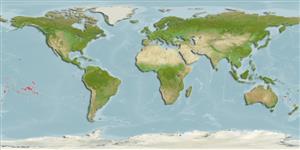Teleostei (teleosts) >
Anguilliformes (Eels and morays) >
Muraenidae (Moray eels) > Muraeninae
Etymology: Gymnothorax: Greek, gymnos = naked + Greek, thorax, -akos = breast (Ref. 45335).
Environment: milieu / climate zone / depth range / distribution range
Ecology
Marine; demersal; depth range 0 - 45 m (Ref. 13539). Subtropical
South Pacific: Southwest Pacific: Lord Howe I. Southeast Pacific: Rapa I., Ducie Atoll, Easter I. and Desventuradas Is.
Size / Weight / Age
Maturity: Lm ? range ? - ? cm
Max length : 37.5 cm TL male/unsexed; (Ref. 13539)
Short description
Morphology | Morphometrics
A plain-colored light brown moray with a black eye ring, white blotches around the last two infraorbital pores and last three mandibular pores, and a single branchial pore.
Ranges from very shallow inshore areas or tide pools to depths of at least 45 m depth (Ref. 13539).
Life cycle and mating behavior
Maturity | Reproduction | Spawning | Eggs | Fecundity | Larvae
Lavenberg, R.J., 1992. A new moray eel (Muraenidae: Gymnothorax) from oceanic islands of the South Pacific. Pac. Sci. 46(1):58-67. (Ref. 13539)
IUCN Red List Status (Ref. 130435)
Threat to humans
Harmless
Human uses
More information
Common namesSynonymsMetabolismPredatorsEcotoxicologyReproductionMaturitySpawningSpawning aggregationFecundityEggsEgg development
Age/SizeGrowthLength-weightLength-lengthLength-frequenciesMorphometricsMorphologyLarvaeLarval dynamicsRecruitmentAbundanceBRUVS
ReferencesAquacultureAquaculture profileStrainsGeneticsElectrophoresesHeritabilityDiseasesProcessingNutrientsMass conversion
Tools
Special reports
Download XML
Internet sources
Estimates based on models
Preferred temperature (Ref.
123201): 20.6 - 29, mean 27.5 °C (based on 186 cells).
Phylogenetic diversity index (Ref.
82804): PD
50 = 0.5000 [Uniqueness, from 0.5 = low to 2.0 = high].
Bayesian length-weight: a=0.00047 (0.00025 - 0.00089), b=3.28 (3.13 - 3.43), in cm total length, based on LWR estimates for this Genus-body shape (Ref.
93245).
Trophic level (Ref.
69278): 3.8 ±0.6 se; based on size and trophs of closest relatives
Resilience (Ref.
120179): Medium, minimum population doubling time 1.4 - 4.4 years (Preliminary K or Fecundity.).
Fishing Vulnerability (Ref.
59153): Low to moderate vulnerability (28 of 100).
